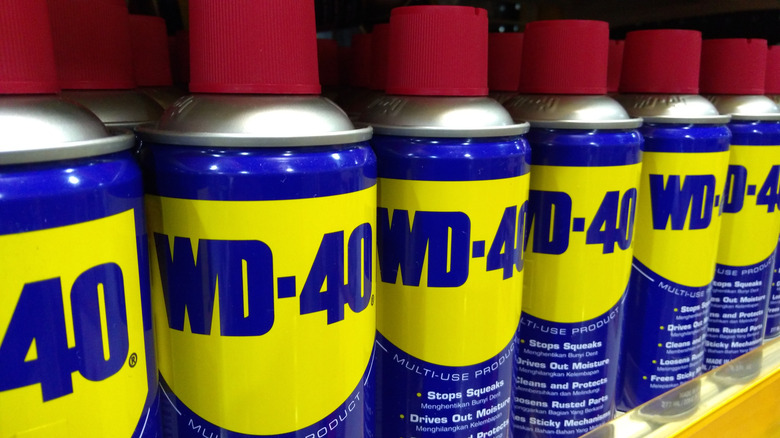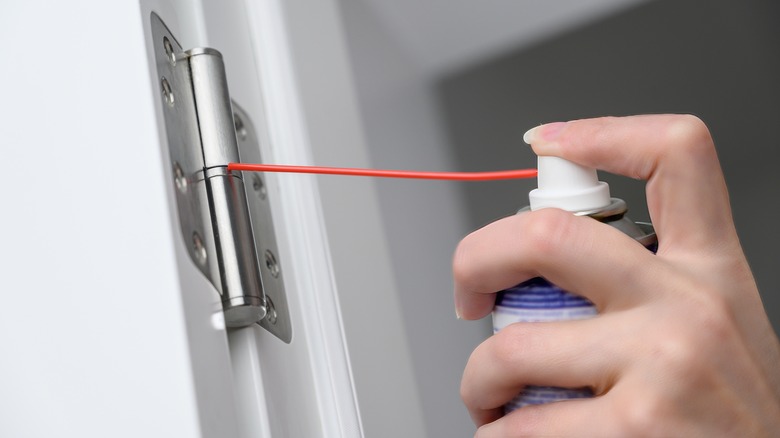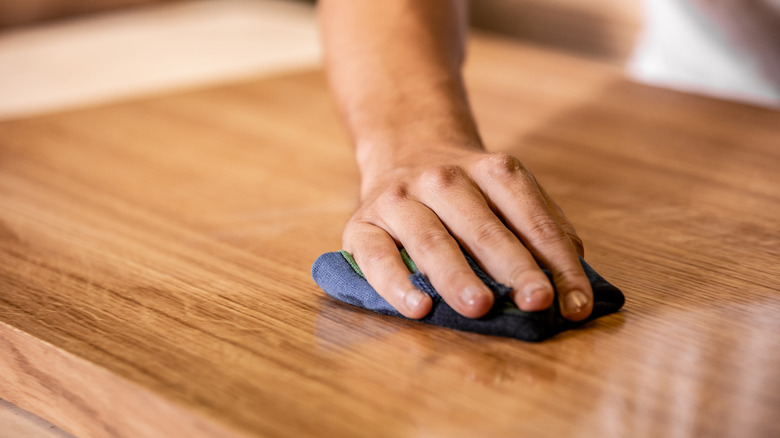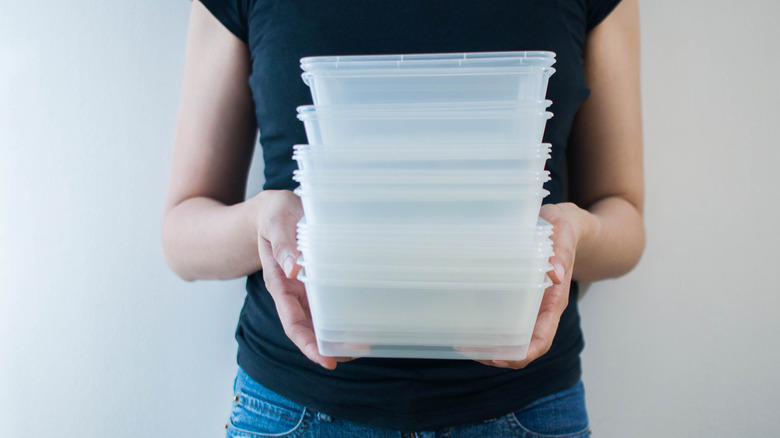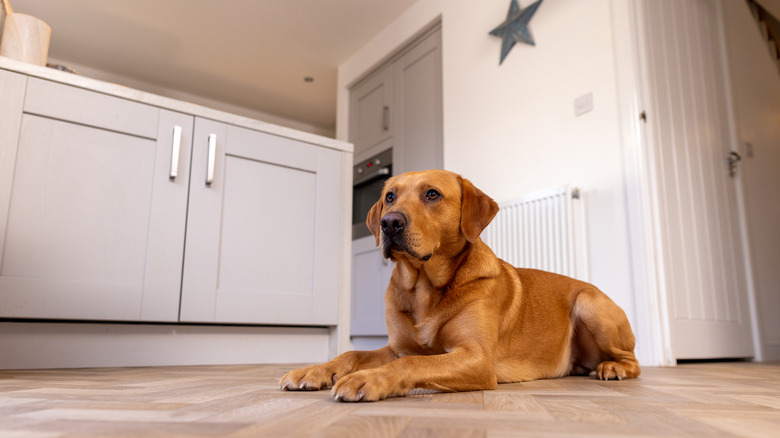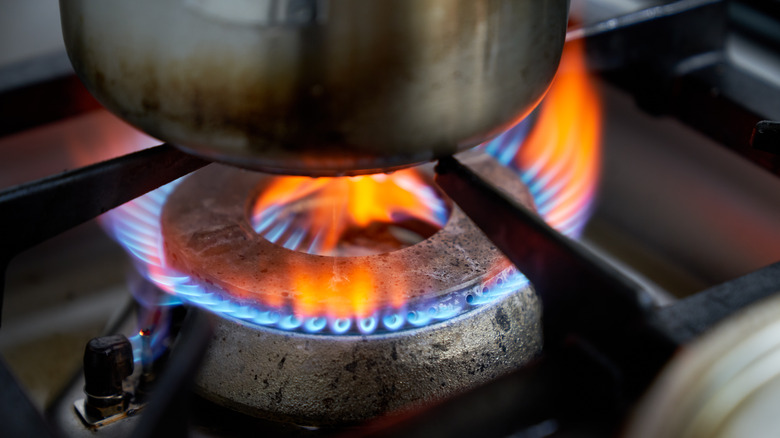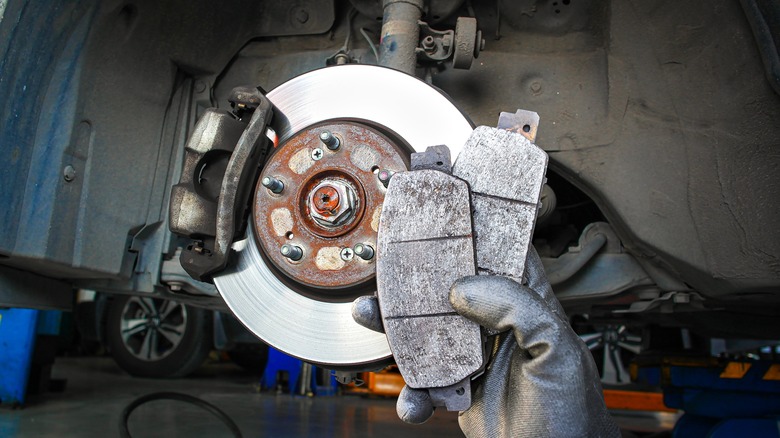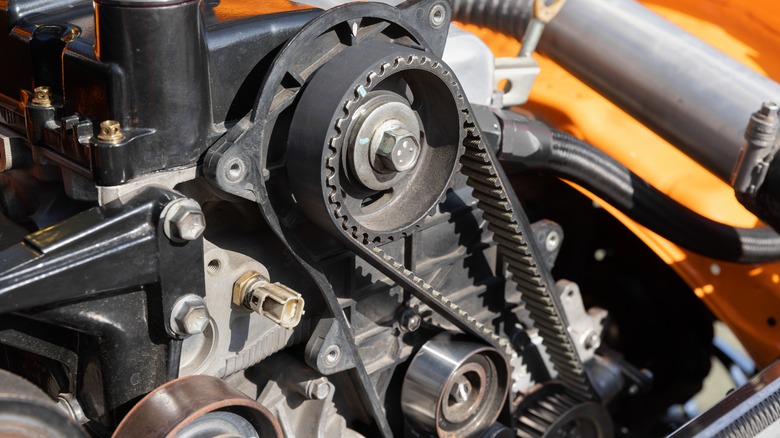10 Mistakes You Might Be Making When Using WD-40
We may receive a commission on purchases made from links.
As far as aerosol sprays go, WD-40 might be one of the most popular ones ever. The famed Multi-Use Product is something of a household name that had lofty origins in the aerospace industry before making its way to ubiquity and a place on the shelves of almost any garage or workshop across the globe. WD-40 and its variants are available in 176 countries and counting, with the WD-40 company recording net sales of $537 million in 2023.
WD-40 has a wide range of legitimate uses, including lubrication, degreasing, and rust penetration. There's even a whole world of hidden uses for WD-40 that encompasses everything from breaking in baseball gloves to removing duct tape residue. There are so many practical uses of WD-40 that you'll never run out of reasons to keep a bottle (or two) of WD-40 handy. As useful as it is, though, there are some situations where using it might be a mistake.
Some, such as using it on a bike chain or on squeaky engine belts, are merely less-than-ideal. However, other WD-40-related mistakes can be dangerous, such as spraying it on your brakes or using it near an ignition source. Here are the WD-40 mistakes you need to be aware of.
Spraying WD-40 on a bike chain
This perhaps isn't the biggest mistake on this list, and one that you could probably get away with most of the time, but we believe it's still worth mentioning. To be fair, WD-40 does market the Multi-Use Product as a lubricant, which means that you should be able to get away with just using WD-40 to lubricate and clean your bike chain — thanks to its grime and dirt-shifting abilities — simultaneously.
However, it's worth noting that aerosols like WD-40 can be tough to apply accurately, and you may end up lubricating components that should stay dry and unlubricated, such as your brakes. This isn't as much of an issue if you have one of the non-aerosol forms of WD-40, but most of you reading will likely just have that standard spray can you get from the hardware store that you use everywhere, which isn't really the right tool for this job. If you have to use it, follow the company's advice and wipe any excess off before you get on your bike.
Besides, original WD-40 isn't a dedicated lubricant — it is, as the name suggests, a multi-purpose liquid — and even WD-40 suggests that you use its Specialist Bike-Chain Lube after cleaning a bike chain with standard WD-40. That's the combo we'd recommend too — clean your chain with standard WD-40 and then apply the specialist lube to ensure smooth operation and a longer-lasting, quieter bike drivetrain.
Lubing hinges with WD-40
To be clear, WD-40 isn't necessarily bad for door or window hinges. It does work as a lubricant — even if common internet wisdom suggests that it's not the best one — and thus will help rid you of the curse of squeaky or noisy hinges, if only temporarily. However, there's more to using WD-40 to lube hinges than a simple spray-and-forget approach.
The WD-40 company is almost evangelical about using WD-40 on squeaky hinges, and it offers a piece of advice that we've seen many homeowners forget to do — clean up afterward. It suggests wiping the hinge down after applying WD-40 to get rid of any excess. Don't leave WD-40 dripping from your hinges, even if your room doesn't have any surfaces that might react negatively to it. WD-40's petroleum base also gives it a bad rap, blamed as it is for attracting dirt and grime to hinges (and other surfaces) once the solvents evaporate — a charge that WD-40 refutes.
That said, it's somewhat telling that it also promotes its own WD-40 Specialist Dry Lube as one that doesn't attract those exact contaminants. WD-40 recommends this PTFE (polytetrafluoroethylene) lube for hinges and window tracks, too, which is something you may want to consider if you find yourself dealing with squeaky hinges more often than you'd like.
Cleaning wooden furniture with WD-40
One of the more common ways to protect wooden furniture is to apply a wax coating, whether natural like carnauba or paraffin-based (or, usually, a combination of the two). It's often the final step in the woodworking process, applied after any finishing oils to seal and protect the furniture, with the bonus effect of giving it a deep shine that looks great to the eye.
Given WD-40's grime-busting abilities, you may be tempted to give your wooden furniture a quick spritz and wipe to see if it helps bring the shine back. However, you should avoid doing so with wax-coated furniture, as WD-40 points out that the classic Multi-Use Product will soften wax polishes and some wax coatings — not what you want to do to a protective coating.
WD-40 claims that you can use it to freshen up old untreated wood furniture, but even then, it recommends only using a small amount to avoid it soaking into the wood. Use it sparingly if you use it at all.
Maintaining your instruments with WD-40
Instruments have a lot of moving parts — a saxophone, for example, has around 600 — and making sure that everything moves freely and works as it should is a key part of keeping your instrument in top shape. There are dedicated oils and greases for this, but you may be wondering if good old WD-40 will work in a pinch. It is, after all, a lubricant.
WD-40 doesn't damage brass or metals, so it shouldn't have any adverse effect on the instrument itself. That said, you may want to keep it away from a saxophone's glued-in pads, for example, given its ability to dissolve glue. However, your instrument isn't what you should worry about here. It'll be fine, even if it's perhaps not the most ideal way to lube a wind instrument. Your health is a whole other matter, though.
The aerosol's fumes aren't necessarily deadly, but inhalation can still cause "drowsiness, dizziness and other nervous system effects," as per WD-40's Material Safety Data Sheet. This means that you don't want to use it in a situation where you'll inhale the vapors — which is exactly what may happen when using it with a brass or woodwind instrument. Given the presence of so many non-toxic lubes, you're much better off keeping the WD-40 in the garage to maintain power tools instead of your sax or flute.
Spraying WD-40 on plastic
Wax isn't the only substance that WD-40 doesn't play nicely with. Certain plastics, specifically clear polycarbonate and polystyrene-based plastics, don't play well with the spray either. Both of those plastics are what's known as amorphous polymers. Amorphous polymers tend to be flexible and transparent plastics that don't shrink during the production process. These characteristics make them great for low-stress products such as safety glasses.
The WD-40 company puts a lot of effort into promoting the spray's multi-purpose nature, but even it advises against using petroleum-based products, like the original WD-40 formula, on polycarbonate and polystyrene. Both plastics may crack or craze when exposed to WD-40, which can eventually lead to the plastic breaking apart along the crack (or cracks). Sure, it won't be hard or expensive to replace a pair of plastic goggles, for example, but why contribute to our growing plastic waste problem by throwing away what would've been a perfectly good pair?
To be clear, WD-40 doesn't damage all plastics. Materials such as polyethylene, Formica, polypropylene, and vinyl have all survived extended immersion in WD-40 without issues. If you know the plastics you're working with, then you'll be fine. If you don't, we recommend playing it safe by holding off on the WD-40.
Spraying WD-40 on food surfaces
WD-40 is not food-safe, and while its Material Safety Data Sheet says it only has "low oral toxicity," ingesting the spray still isn't fun: it can cause nausea, vomiting, and general irritation to your gastrointestinal tract. In other words, WD-40 can bother pretty much every part of the body that your food touches, from the mouth and throat that swallows the food right down to the organs that help you digest it.
However, WD-40 doesn't just potentially irritate your digestive system if swallowed, as it also poses an aspiration risk, which is when food or drink makes its way into the airway instead of down into the digestive system. WD-40 points out that the substance is potentially fatal if this happens, so it's definitely not a risk you should take by spraying WD-40 onto surfaces that are close to or will come in contact with food soon after you use it.
WD-40 is great for cleaning stainless steel, so there's definitely a use for it in the kitchen — just make sure that you don't get it all over other surfaces and wipe your stainless steel surfaces down properly before cooking. If you need to lube hinges in your oven, for example, you'll likely be safer with WD-40 Food Grade Silicone spray.
Exposing your pets to WD-40
It's not too hard for humans to avoid touching or ingesting WD-40, but that's not something you can say about pets. As intelligent as our furry friends are, you can't exactly tell your pets not to lick a recently sprayed surface or hinge. Instead, you'll want to ensure that your pets stay well away from any WD-40 applications that they might end up licking or otherwise coming into contact with.
As with humans, WD-40 can pose issues to your pets if they swallow it. It can cause digestive issues — which are no joke for a dog — but that's not the only problem. There's a chance that the WD-40 will make its way into the airway instead, which doctors call aspiration. When that happens, the otherwise low-toxicity multi-purpose spray turns into a potential killer. The Material Safety Data Sheet says that aspiration of WD-40 can cause "chemical pneumonitis, severe lung damage and death" — none of which are particularly fun for pets (or humans, for that matter).
So, keep your pets away if you're planning to go ham with the WD-40, and ensure that it dries before you let them come anywhere near it. How you do that is, of course, entirely up to you.
Using WD-40 on hot surfaces or near open flames
WD-40 consists of aliphatic hydrocarbons in a petroleum base oil, so it shouldn't come as too much of a surprise that the Material Safety Data Sheet warns that the solution is extremely flammable. You should keep the WD-40 away from "heat, sparks, open flames, [and] hot surfaces" and also avoid spraying it on an open flame or ignition source. Yes, that includes cigarettes — no smoking with a can of WD-40 in your hand.
This encompasses a wide range of surfaces and appliances in the home and elsewhere. Some might be obvious, like a gas stove or space heater, but you'll also want to look out for more minor and easily forgotten heat sources such as pilot lights, which are present on water heaters, for example. This means you should also keep the WD-40 away from hot exhaust pipes and engine blocks.
You also have to watch out for more than just the aerosol spray itself. WD-40's vapors are heavier than air and can follow surfaces to reach flames or ignition sources that are well out of your immediate vicinity. This can set the gas on fire and potentially causing flames to flash back to you along the vapor trail. The cans of WD-40 themselves are also heat-sensitive, with a chance of blowing up if subjected to extreme heat.
Lubing your brakes with WD-40
Yes, WD-40 is useful for silencing squeaky hinges, but it's not the solution for all the squeaks and scrapes in your life. Especially not when the squeaking is from a system that relies on friction to do its job, like your car's brakes. Noisy and squeaking brakes are annoying, but the last thing you want to do is spray an oil-based lubricant to minimize the rubbing in hopes of reducing the noise. Car brakes work entirely on friction, and applying an aerosol lube willy-nilly is counterintuitive — and potentially dangerous.
Brakes squeak for many reasons, including worn brake pads, corrosion on the brake discs, or debris caught in the pads or rotors, and WD-40 won't be of much use here. If you have dirty brakes, a non-lubricating brake cleaner is what you want. If the pads are worn, then it's time to replace them. Corroded brake discs won't magically clean up with WD-40, and you'll need to use a bit of elbow grease to get the rust off.
To be clear, keeping your brakes in tip-top shape will require some lubrication, but you'll want to use a dedicated brake grease and only apply it to specific areas and stay away from the friction surfaces themselves.
Using WD-40 on a squeaky engine belt
We get it — squeaky engine belts can be very annoying. However, no matter how irritated you are, and how appealing it might sound to spray a bit of WD-40 onto the belt in the hopes of quieting it down, WD-40 is one thing you definitely do not want to use on your engine belts. Maintaining the correct belt tension is critical, and a lubricant is likely one of the worst things you could apply when you're trying to keep belts under tension.
Engine belt squeal is often caused by not having enough tension in the system. This can be due to a contaminated, old, or overly long belt, none of which WD-40 will help with. In fact, the petroleum base oil in WD-40 might actually cause slippage due to its lubricative nature, which in turn will cause even more squealing as the belt tension drops further. You don't want to use WD-40 on a chirping belt either, as the chirping is most likely due to a misaligned pulley and not any sort of friction.
If you want to get rid of the squeaking without replacing your belt or working on the drive system, then a belt dressing spray might be a useful temporary measure. These sprays, like the WD-40 Specialist Belt Dressing that the company sells in certain regions — seemingly not in the U.S., unfortunately — try to rejuvenate the rubber, which can help extend a belt's life and quiet it down at the same time.
